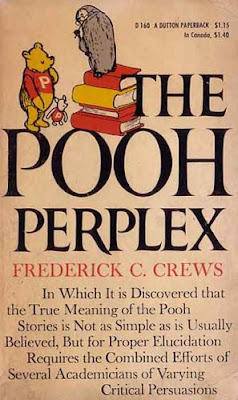This blog is about a little book that was published in 1963 by the UC Berkeley Professor Frederick C. Crews. Crews was on the faculty at Berkeley, when I attended there in the latter half of the 1960's (Crews has been emeritus for some years). But I never took any courses from him. Perhaps he was on sabbatical, or maybe he was teaching courses I wasn't interested in just then. The way a man teaches is not necessarily the way he writes, and I think I would probably have been disappointed if I thought taking a course with Crews would be an amusing diversion from the heavy going of the core courses in Chaucer, Milton, Shakespeare and Johnson. Still, at least Crews possessed a genuine, mischievous sense of humor--something English professors in those days generally lacked. The full professors were usually deep into some lugubrious magnum opus, and jealously guarded their free time away from teaching, while the assistants and associates were bogged down in departmental duties and the necessity of getting their doctoral theses expanded into a publishable state. It was the old academic rat race.

I had always expected that I was destined to become a literary critic of some sort. English majors--those who survived the drudgery and hurdles set before them on the long road to their Ph.D.--had, by the time they attained their goal (a minor teaching position somewhere), become so accustomed to thinking critically about literature, that the notion of performing any other task than deconstructing established texts would have seemed unimaginable. The primary problem was to acquire the "tools" to understanding, choose an area (or an author) of concentration, and propose a modestly new theory that would form the basis for one's identity as a full-fledged academic.
Critical literary theory and practice is not a new thing--poets and essayists have been writing about literature for thousands of years--but the application of strict disciplines--psychology, linguistics, categorical cultural-linked (race, ethnography, gender, class, politics)--to literary artifacts exploded in the 20th Century. With the growth of the post-secondary education, and the academic factory-system turning out humanities graduates in far greater numbers, criticism as a professional enterprise really got going. This burgeoning body of secondary, parasitic textuality became so developed, that it literally began to take on a life of its own, to the extent that criticism itself was seen to be, and eventually thought of itself, as a legitimate separate branch of literature, self-sufficient and self-sustaining--almost beyond the need for a parent or instigating text to inspire it.
Crews was probably the first serious critic to take on the role of humorist in confronting this proliferating critical army, to attack its coteries and oddballs and hybridized specialists, and to shed a little light on the extreme or austere lengths to which people would go to apply some arcane or over-enthusiastically partisan point of view on a literary work. It was the ultimate satire of manners, a book of parodies of critic-types drawn from the spectrum of literary humbuggery--the little journals, the staid organs of safely obscure ratiocination, the lecterns and podia of the exegetical circuit, all busily spinning out embroideries of opinion, pronouncement and theory. It was called The Pooh Perplex [New York: E.P. Dutton, 1963].
In the intervening years since Crews's little book was published, there have been other employments and spin-offs of the A.A. Milne's little children's classic Winnie-the Pooh [1926]. It's been translated into Latin, there's the Tao of Pooh, and the Te of Piglet, and Milne eventually published four books in the Pooh series. The Pooh franchise, beginning in 1930, became one of the most lucrative of its kind in history, and eventually, under Disney's use, among the most disputed. Like Peanuts, Madeline, Eloise, Babar, Raggedy Anne and the Oz books, Pooh is pure promotional gold.
A.A. Milne [1882-1956] wrote five books about the Pooh characters. Christopher Robin is based on Milne’s son Christopher, and Pooh-bear is based on a Canadian bear donated to the London Zoo during the first World War. Both Milne, and E.H. Shepard, the illustrator of the Pooh books, worked for Punch, the British humor magazine. Milne, a playwright, tried his hand at several literary genres, with limited success. In later life, both Milne and Shepard grew weary of the Pooh franchise, and neither realized the greater part of the income that flowed from it. The setting for the Pooh stories is a semi-rural area south of London, the Ashdown Forest in Sussex. As Christopher Milne grew up, his father lost interest in his Pooh narratives, and never revisited them.
The Pooh characters are hybrid toy animals who can talk, and carry on lives which are partly domestic. Children tend to identify with Christopher Robin, and to be amused at the antics and predicaments of the animal characters. Pooh waddles about getting himself into logical dilemmas. As a literary archetype, children's literature has become as much a subject of analysis as classic adult literary tropes--which is partly the joke that Crews's little book plays off of. In the next installment, I'll address the parody-essays in The Pooh Perplex.



Tidak ada komentar:
Posting Komentar